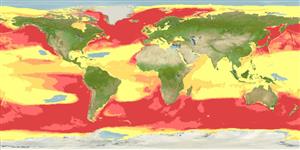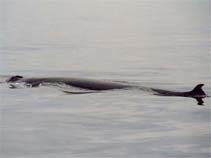Balaenoptera physalus (Linnaeus, 1758)
Fin whale| Native range | All suitable habitat | Point map | Year 2050 |

|
| This map was computer-generated and has not yet been reviewed. |
| Balaenoptera physalus AquaMaps Data sources: GBIF OBIS |
Classification / Names ชื่อสามัญ | ชื่อพ้อง | CoL | ITIS | WoRMS
Mammalia | Cetartiodactyla | Balaenopteridae
Environment: milieu / climate zone / ระดับความลึก / distribution range นิเวศวิทยา
ผิวน้ำ; สัตว์น้ำที่อาศัยและอพยพภายในทะเลเท่านั้น (อ้างอิง 75906); ระดับความลึก 0 - 230 m (อ้างอิง 1005). Tropical; 90°N - 90°S, 180°W - 180°E
Distribution ประเทศต่างๆ | พื้นที่จำแนกตาม FAO | ระบบนิเวศหลายระบบ | การปรากฏขึ้น,การเกิดขึ้น,พบ | การแนะนำ
Circumglobal except the Arctic: Balaenoptera physalus physalus: Svalbard, Barents Sea, North Carolina, Portugal, Cantabrian Sea, Newfoundland, Gulf of Mexico, Greater Antilles, Faroe Islands, Norway, Canary Islands, Sea of Okhotsk, Kuril Islands, Bering Sea, Chukchi Sea, Gulf of Alaska, Sea of Japan, Japan, Taiwan, Ogasawara, Hawaii, California, Baja California, Gulf of California; Balaenoptera physalus quoyi: Ross Ice Shelf, Brazil, Gabon, Angola, Namibia, South Africa, Madagascar, Western Australia, New Zealand, Colombia, Peru, Chile (Ref. 1522).
Length at first maturity / ขนาด / Weight / Age
วัยเจริญพันธุ์: Lm ? range ? - ? cm Max length : 2,700 cm TL เพศผู้/กระเทย; (อ้างอิง 1394); น้ำหนักสูงสุดที่มีการรายงาน: 75.0 t (อ้างอิง 1394)
Life cycle and mating behavior วัยเจริญพันธุ์ | การสืบพันธุ์ | การวางไข่ | Eggs | ความดกของไข่ | Larvae
Main reference
อ้างอิง | ผู้ประสานงาน | ผู้ร่วมมือ
Jefferson, T.A., S. Leatherwood and M.A. Webber 1993 FAO species Identification Guide: Marine Mammals of the World. Rome, FAO. 320 p. + 587 figures. (อ้างอิง 1394)
IUCN Red List Status
(อ้างอิง 130435: Version 2025-1)
CITES status (อ้างอิง 108899)
CMS (อ้างอิง 116361)
Threat to humans
Human uses
การประมง: การค้า
FAO - การประมง: landings, species profile | FishSource | ทะเลรอบๆเรา
เครื่องมือ
ข้อมูลเพิ่มเติม
Max. ages / sizes
Length-weight rel.
Length-length rel.
Length-frequencies
Mass conversion
อุดมสมบรูณ์
แหล่งที่มาจากอินเตอร์เน็ต
BHL | BOLD Systems | CISTI | DiscoverLife | FAO(การประมง: species profile; publication : search) | Fishipedia | GenBank (genome, nucleotide) | GloBI | Gomexsi | Google Books | Google Scholar | Google | PubMed | แผนภูมิชีวิตแบบต้นไม้ | Wikipedia (Go, ค้นหา) | บันทึกทางด้านสัตววิทยา



